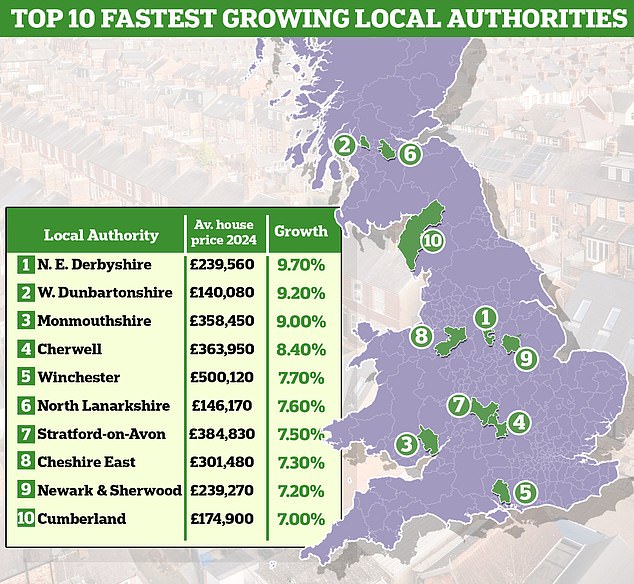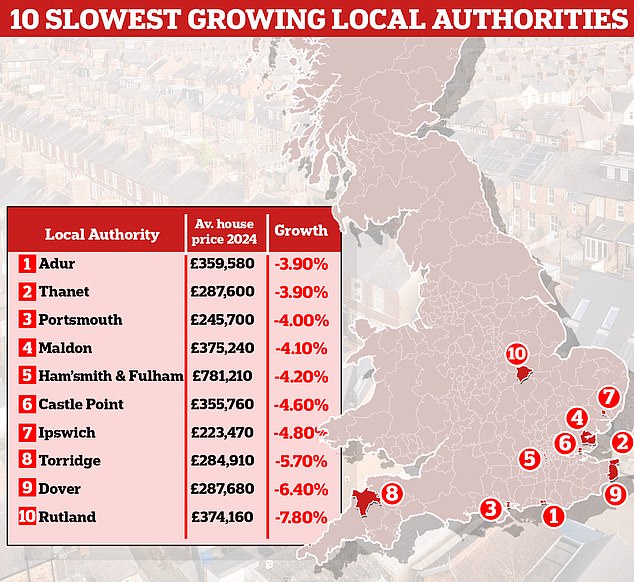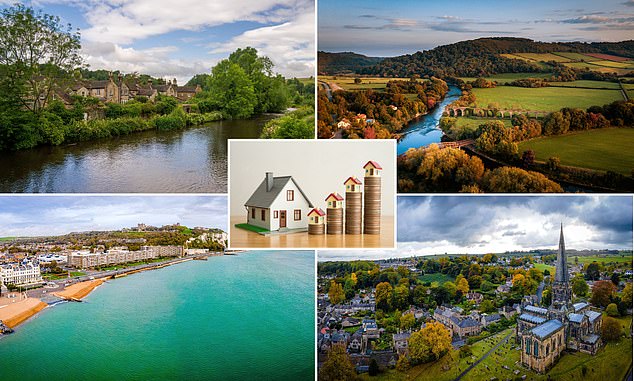Average house prices rose by 2.8 per cent in the 12 months to August this year, according to the latest figures from the Office for National Statistics.
But that may not be the case where you live, as local real estate markets may operate very differently.
Estate agent Hamptons analyzed ONS data and revealed that a Midlands market is the most active in the UK when it comes to house price growth over the past year.
House price winners and losers: North East Derbyshire and Monmouthshire have seen house prices rise by almost 10 per cent over the past year, while prices in Dover have plunged.
Homeowners in north east Derbyshire have seen prices rise the most, up 9.7 per cent in the year to August.
The typical property in the rural district, which includes towns on the outskirts of Chesterfield such as Dronfield and Clay Cross, now sells for £239,560, down from £218,340.
The district is perfect for people looking for a more rural life, but also offers short travel distances to cities such as Sheffield, Derby and Nottingham.
West Dunbartonshire in Scotland is the next best performing local authority, where average house prices increased by 9.2 per cent.
The typical property now sells for £140,080, up from £128,278 a year earlier.
The area incorporates part of the Loch Lomond & The Trossachs National Park, but is also within walking distance of Glasgow city centre.
Aneisha Beveridge, head of research at Hamptons, says areas on the outskirts of cities have benefited the most from house price growth this year.

Top wins: These 10 areas have seen their home prices rise the most in the year to August
“As mortgage rates have fallen, buyers who remain locked out of cities have increasingly sought out slightly more affordable fringe areas,” says Beveridge.
‘These moves are being driven by first-time and second-time buyers, who found it difficult to buy when rates peaked last year.
“As many of these younger generations will have to work more from the office this year, they are eager to have the best of all worlds: affordable housing with urban amenities nearby.”
Monmouthshire, in Wales, has also seen spectacular house price growth: the average house there has risen 9 per cent year-on-year, from £328,853 to £358,450.
Verona Frankish, chief executive of real estate website Yopa, attributed this to the location of two bridges connecting England and Wales.
“The property market in Monmouthshire is performing very strongly and there are two key reasons for this: the Prince of Wales Bridge and the Severn Bridge,” he says.
‘Monmouthshire is home to the best that Wales has to offer – historic towns, vibrant culture and exceptional areas of natural beauty.
‘As a result, it offers an extremely high quality of life, but with the added benefit of quick and easy access to England, as well as the rest of Wales, making it extremely popular with Welsh and English buyers.
“Therefore, those looking to buy in the area have a much stronger financial situation than most and this has allowed them to better cope with the higher purchase costs in recent times, which in turn has kept the real estate market buoyant in Monmouthshire.”
Where have house prices fallen?
Coastal areas in southern England have seen some of the biggest falls in house prices in the year to August, according to Hamptons research.
Eight of the 10 areas that recorded the biggest price drops over the last year are on the coast.
Beveridge says: “Towns along the south coast, popular during the Covid years, have seen price falls after some years of strong growth.”
This includes Adur in West Sussex, Thanet in Kent and Portsmouth in Hampshire.

Sea change: Coastal cities saw some of the biggest house price drops last year
However, prices in Rutland, in the East Midlands, saw the biggest falls, having fallen 7.8 per cent year-on-year from £405,750 to £374,160, wiping an average of £31,590 off the value of a typical home.
The small county has only one train station, which may have affected its popularity among travelers since the pandemic.
It’s a similar story for prices in Dover, where the average asking price has fallen 6.4 per cent from £307,450 to £287,680. That equates to £19,770 shaved off the value of the average home.
Marc von Grundherr, director of the estate agency Benham and Reeves, says the property market in Dover has been affected for several reasons.
“The first reason is that the scramble for coastal properties that materialized during the pandemic has simply subsided,” says von Grundherr.

Expert: Marc Von Grundherr, director of the Benhams & Reeves real estate agency
‘This has reduced the level of buyer demand for such locations, which in turn has caused house prices to cool.
Dover’s image has also been affected by illegal immigration, according to von Grundherr.
“We are seeing weekly headlines about the number of illegal immigrants attempting to cross the channel, with more than 800 arrivals in the last week alone,” he adds.
‘The Channel Crossing is the UK’s gateway to Europe and, whilst it is not the only point of arrival for these migrants, it is becoming synonymous with a problem that will always deter buyers.
‘It is also important to consider that despite sharp reductions in property values, the average home in Dover is still just below the UK average.
“So it’s certainly not an affordable part of the market, meaning buyers will likely struggle with higher borrowing costs.”
Torridge, in north-west Devon, has also seen house prices fall by 5.7 per cent, according to Hamptons analysis, the equivalent of £17,200 for an average home in the borough.
Some links in this article may be affiliate links. If you click on them, we may earn a small commission. That helps us fund This Is Money and keep it free to use. We do not write articles to promote products. We do not allow any commercial relationship to affect our editorial independence.


